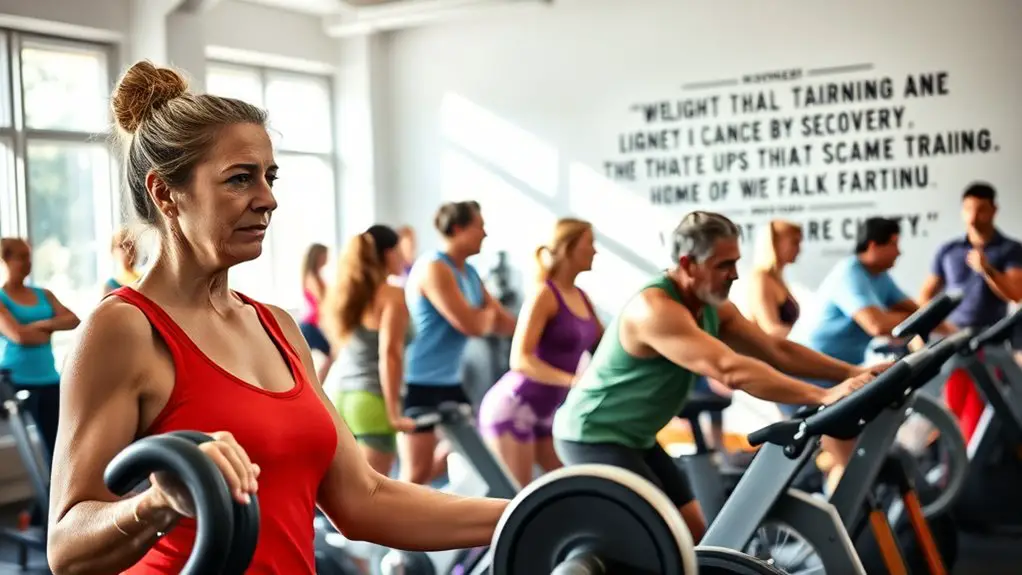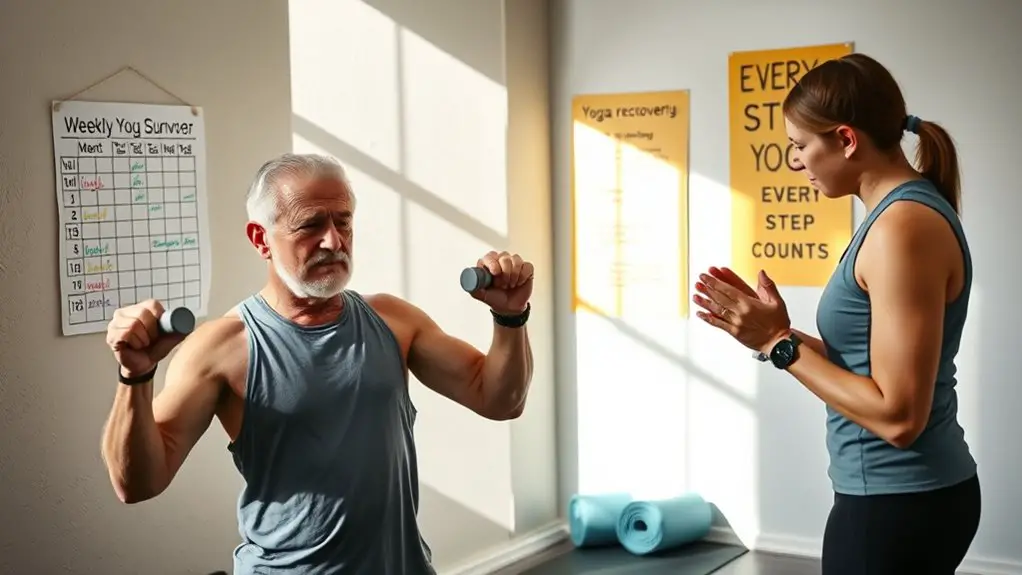The Role of Gym Training in Cancer Recovery and Rehabilitation

Gym training plays a crucial role in your cancer recovery and rehabilitation journey. Through structured workouts, you can combat fatigue, rebuild strength, and improve your quality of life. Exercise not only enhances physical health but also supports your emotional well-being, fostering resilience and reducing anxiety. Tailoring programs to your individual needs and celebrating incremental progress can keep you motivated. Engaging with a supportive community further enriches your experience, and there’s much more to explore about these benefits.
Understanding the Impact of Cancer Treatment on Physical Health

When you undergo cancer treatment, it’s common to experience a range of physical health changes that can impact your overall well-being. Chemotherapy effects, such as fatigue, nausea, and muscle weakness, can greatly alter your daily life. These symptoms often stem from the way chemotherapy targets rapidly dividing cells, affecting not only cancerous cells but also healthy ones.
Similarly, the radiation impact can lead to localized side effects, including skin irritation and changes in tissue integrity, which may hinder your mobility and physical strength. Understanding these challenges is vital, as they can affect your ability to engage in regular activities and exercise.
Recognizing these physical changes allows you to better address them during your recovery process. It’s important to consult healthcare professionals who can guide you through appropriate interventions, enabling you to regain strength and improve your quality of life as you navigate the road to recovery.
The Psychological Benefits of Exercise for Cancer Survivors
While traversing the aftermath of cancer treatment, many survivors find that engaging in regular exercise can greatly enhance their psychological well-being. Exercise not only improves physical health but also fosters emotional resilience, helping you cope with the ongoing challenges of recovery. Incorporating mindfulness techniques during workouts can further elevate these benefits.
- Boosts mood and reduces anxiety through the release of endorphins.
- Improves self-esteem by promoting a sense of accomplishment.
- Creates a supportive community, reducing feelings of isolation.
Building Strength and Endurance Through Structured Gym Training

As you commence on the journey of cancer recovery, structured gym training can be an essential component in rebuilding your strength and endurance. Engaging in strength training is particularly beneficial, as it helps counteract muscle loss and fatigue often experienced during treatment. Research indicates that incorporating resistance exercises can improve overall physical function and quality of life.
Endurance exercises, such as walking or cycling, also play a significant role in enhancing cardiovascular health and stamina. These activities not only help you regain energy but also promote better mood and reduce anxiety.
Combining both strength and endurance training in a structured program can lead to significant improvements in your physical capabilities and emotional well-being. It’s important to approach this training gradually, allowing your body to adapt while ensuring safety and effectiveness. By committing to these exercises, you’re taking proactive steps toward a healthier, more resilient future.
Tailoring Exercise Programs to Individual Needs
Tailoring exercise programs to individual needs is crucial for maximizing the benefits of gym training in cancer recovery. Personalized assessments help identify your unique physical capabilities and limitations, allowing for the development of effective and adaptive techniques. This approach not only enhances your physical health but also boosts your emotional well-being.
Tailored exercise programs in cancer recovery enhance physical health and emotional well-being through personalized assessments and adaptive techniques.
Consider these aspects when designing your exercise program:
- Physical capabilities: Understanding your current fitness level guarantees exercises are safe and effective.
- Emotional readiness: Acknowledging your mental state can profoundly influence your motivation and adherence.
- Recovery goals: Setting realistic, achievable goals keeps you focused and fosters a sense of accomplishment.
Overcoming Treatment-Related Fatigue With Physical Activity

Treatment-related fatigue can feel overwhelming, but engaging in physical activity can be a powerful tool for alleviating those feelings of exhaustion. Research shows that incorporating regular, moderate exercise helps improve energy management and can lead to significant fatigue reduction in cancer survivors. When you move your body, even in small increments, it stimulates the release of endorphins, which can enhance your mood and energy levels.
Start with gentle activities like walking, stretching, or yoga, gradually increasing intensity as you feel comfortable. This approach not only combats fatigue but also helps maintain muscle strength and flexibility, which are essential during recovery. Listening to your body is key; it’s about finding a balance that works for you. By prioritizing physical activity, you’re not just fighting fatigue—you’re actively participating in your recovery journey, fostering resilience and a sense of empowerment.
The Role of Gym Training in Enhancing Quality of Life
Engaging in gym training can considerably enhance your quality of life during cancer recovery. Improved physical fitness not only boosts your strength and endurance but also positively impacts your mental health and well-being. Additionally, the social interactions you experience in a gym setting can foster a sense of community and support, further promoting recovery.
Physical Fitness Benefits
As you navigate the journey of cancer recovery, incorporating gym training can greatly enhance your quality of life. Engaging in regular physical activity not only supports muscle recovery but also improves cardiovascular health, helping you regain strength and energy.
Consider these emotional benefits of gym training:
- Empowerment: You’ll feel in control of your body and health.
- Connection: Building relationships with fellow gym-goers fosters a sense of community.
- Achievement: Every workout completed becomes a reflection of your resilience.
Research shows that structured exercise can reduce fatigue, enhance mobility, and improve overall well-being. By committing to a fitness regimen, you’re investing in your health and establishing a foundation for lifelong wellness.
Mental Health Improvement
While guiding through the complexities of cancer recovery, it’s essential to recognize how gym training can greatly enhance your mental health. Engaging in regular physical activity not only improves your physical well-being but also fosters emotional resilience. Exercise stimulates the release of endorphins, which can alleviate anxiety and depression, creating a more positive outlook. Incorporating mindfulness techniques, such as focused breathing during workouts, can further enhance your mental clarity and reduce stress. By setting achievable fitness goals, you cultivate a sense of accomplishment, promoting self-esteem and motivation. These elements collectively contribute to a more balanced mental state, making the journey through recovery not only manageable but also enriching. Overall, gym training serves as a crucial tool in improving your quality of life during this challenging time.
Social Interaction Opportunities
The gym can be an essential space for social interaction, especially during cancer recovery. Engaging in group activities fosters social connections, which can greatly enhance your quality of life. Building these relationships can help combat feelings of isolation often experienced during recovery.
- You’ll find encouragement and support from others who understand your journey.
- Shared experiences can create deep bonds and lasting friendships.
- Participating in group classes can boost your motivation and enjoyment.
Research shows that social interaction is vital for emotional well-being, aiding in the recovery process. By connecting with others in the gym, you’re not just improving your physical health; you’re also nurturing your emotional resilience, making your recovery journey more holistic and fulfilling.
Fostering a Supportive Community Through Group Workouts
Creating a sense of community through group workouts can greatly enhance the recovery journey for cancer survivors. Engaging in exercise within a supportive environment fosters connections and combats feelings of isolation. Research shows that community engagement is crucial for psychological well-being, making it essential for your recovery process.
Group workouts not only provide physical benefits but also promote group motivation. Exercising alongside others who share similar experiences can inspire you to push through challenges, encouraging resilience and accountability. This collective effort can lead to improved emotional health, as you find strength in camaraderie.
Moreover, participating in group activities allows you to share your journey, fostering empathy and understanding among peers. This supportive atmosphere can be a powerful tool in your rehabilitation, reinforcing the idea that you’re not alone in this journey. Ultimately, building a community through group workouts can greatly influence your recovery, both mentally and physically.
Setting Realistic Goals and Tracking Progress

Setting realistic goals and tracking your progress are essential components of a successful recovery from cancer. By defining achievable objectives, you empower yourself to take control of your rehabilitation journey. Effective goal setting can include:
- Improving strength: Focus on small, incremental gains rather than overwhelming yourself with expectations.
- Enhancing endurance: Aim for manageable durations of activity to gradually increase your stamina.
- Boosting flexibility: Incorporate gentle stretching exercises to improve range of motion without causing strain.
Progress tracking is equally important. Keeping a record of your workouts and milestones can foster motivation and provide insight into your recovery. It’s particularly beneficial to celebrate small victories, as they reinforce your commitment and can greatly enhance your emotional well-being. Remember, recovery is a journey; celebrate each step forward and adjust your goals as needed to stay aligned with your evolving capabilities.
Long-Term Benefits of Maintaining an Active Lifestyle Post-Recovery
Maintaining an active lifestyle after cancer recovery offers numerous long-term benefits that can greatly enhance your quality of life. Engaging in regular physical activity not only improves physical health but also contributes to emotional well-being. Exercise has been shown to reduce the risk of recurrence and improve overall survival rates.
Establishing sustainable habits is essential for long-term success. By incorporating exercise into your daily routine, you create a foundation for ongoing health. This can enhance your long-term motivation, making it easier to stay committed to your goals.
Additionally, an active lifestyle can help manage symptoms related to treatment, such as fatigue and anxiety, while boosting your energy levels. Social interactions from group activities foster a sense of community, further supporting your mental health. Overall, the benefits of maintaining an active lifestyle after recovery extend beyond physical fitness, promoting a healthier, happier life.
Frequently Asked Questions
Can Gym Training Affect My Cancer Treatment Schedule?
Yes, gym training can affect your cancer treatment schedule. If you’re increasing your training frequency or workout intensity, it’s essential to communicate with your healthcare team. They’ll help assess how your exercise regimen interacts with your treatment plan. While moderate exercise can be beneficial, excessive strain might lead to fatigue or complications. Always prioritize your health and adjust your workouts as needed to guarantee a balanced approach during your treatment journey.
What Types of Gym Equipment Are Best for Cancer Survivors?
Imagine a tree regrowing after a storm; strong roots are essential. For cancer survivors, the best gym equipment includes resistance bands and light free weights for strength training, promoting muscle rebuilding. Cardio exercises like stationary bikes or elliptical machines boost endurance and heart health. A 2019 study showed that combining both types of workouts can lead to improved overall well-being. You’re not just recovering; you’re nurturing your strength and resilience.
How Can I Find a Gym That Accommodates My Needs?
To find a gym that accommodates your needs, start by considering your personal preferences for equipment and classes. Look for facilities that prioritize accessibility, ensuring they have ramps, elevators, and suitable restrooms. It’s also helpful to read reviews or visit gyms to gauge their atmosphere and staff support. Speak with trainers about your specific requirements; they can often provide insights tailored to your situation, ensuring you feel comfortable and supported in your fitness journey.
Are There Any Risks Associated With Gym Training During Recovery?
Yes, there are risks associated with gym training during recovery. It’s essential to prioritize injury prevention and fatigue management. You might experience fatigue or other side effects, so listen to your body and adjust your intensity accordingly. Consulting a healthcare professional before starting any training program can help tailor your workouts to your needs, minimizing risks. Regular assessments can further guarantee that your regimen supports recovery while keeping any potential risks in check.
Should I Consult My Doctor Before Starting a Gym Program?
Did you know that nearly 70% of individuals benefit from consulting their doctor before starting a gym program? It’s essential to discuss your medical history and any specific concerns you might have. Your doctor can provide tailored guidance that aligns with your health needs, ensuring you engage in safe, effective exercises. This consultation not only helps you avoid potential risks but also maximizes the benefits of your fitness journey. Don’t skip this important step!





